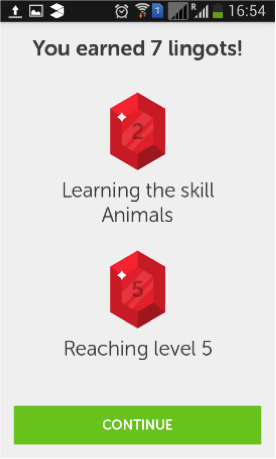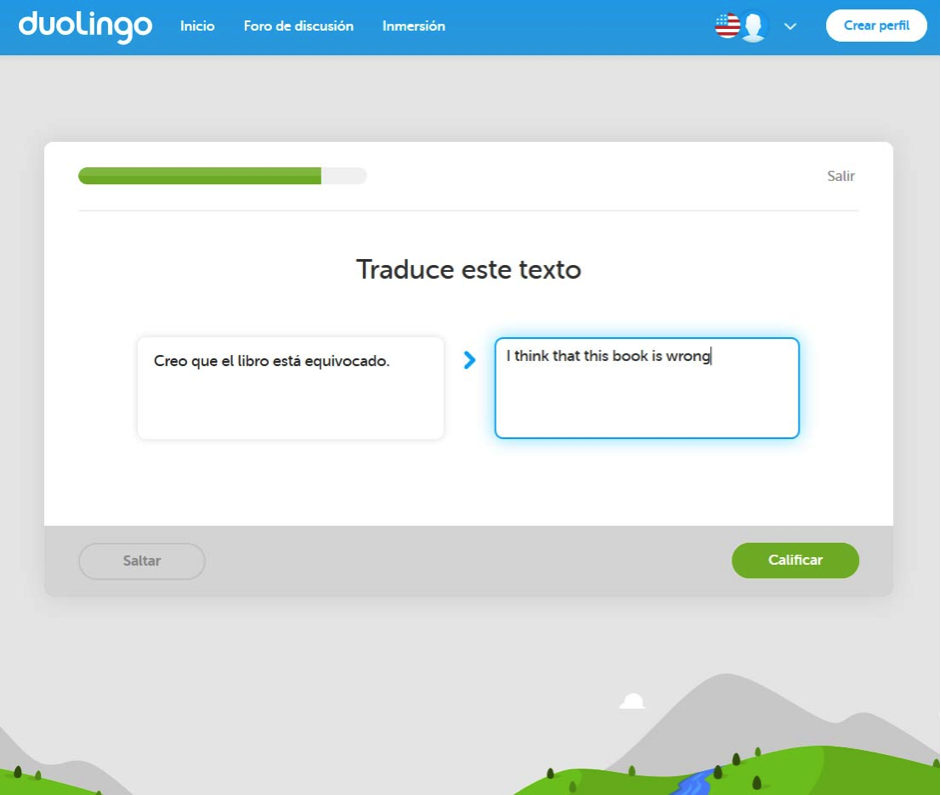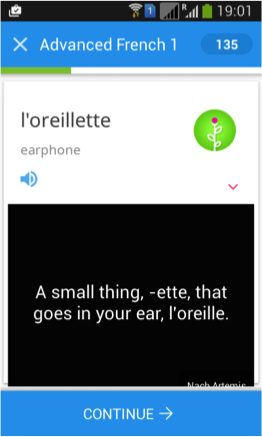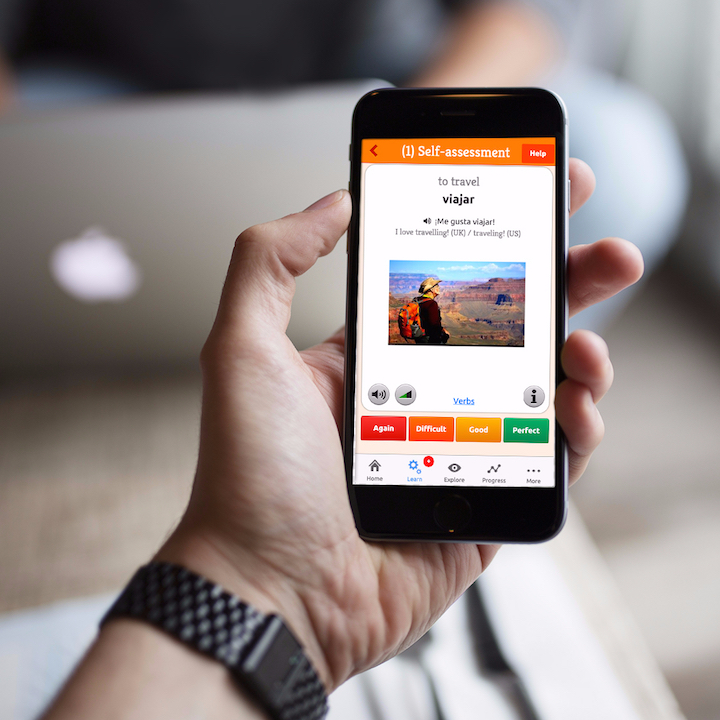It wakes you up in the morning with some ghastly and unwelcome alarm noise, but you forgive it. Perhaps you couldn’t sleep after a late-night glance at your social media spiralled into hours of Facebook stalking. We’ve all been there.
Admit it… one of the closer relationships in your life right now is with your phone.
So how about letting it teach you a new language?
A range of language learning apps are available to help you do just that. The proposition is tempting – use the time that you would otherwise waste on games doing something productive instead.
The most popular free apps are duolingo (which has around 20,000,000 active users) and memrise, a tool that helps you memorise vocabulary. MosaLingua is another very popular paying app. Starting from the principle that learning should also be fun, all these apps find ways to reward you for memorising vocabulary and understanding the grammar.
Gamification
Time passes much more quickly when shifting blocks in Tetris or smashing digital sweets in Candy Crush Saga than when shifting numbers in a spreadsheet, although the spreadsheet and the games both essentially involve completing repetitive tasks on a computer screen.
Games are designed to offer instant gratification, whether through flashing lights, points or some other form of reward. Slot machines have worked on this principle for years.
The idea of gamification is to make boring tasks more fun by adding the gratifying elements from games.
The new generation of language learning apps keep you interested by incorporating video-game staples such as points, lives, leaderboards, levels and cheery noises when you do something well, such as completing a test.
You can also save up rewards in the app to open up new challenges or make aesthetic changes, although unlike the typical ‘freemium’ model, there are no in-app purchases involving real money.
Duolingo in action
Duolingo is very easy to get started with. You choose which language you want to learn, sit a placement test or simply start at the beginning and then get started with the exercises.
You learn through a variety of tasks such as translating text to/from the language you are learning, transcribing audio (from computer-generated speech), identifying all correct translations of a sentence and even reading out a sentence into your phone, which voice-recognition software then analyses (although not especially well).

The exercises are split into vocab themes (e.g. animals, food) or verbs, adjectives, etc. You are not explicitly taught the logic and concepts behind the language, but you should pick them up as you answer questions. You can, for example, tap a part of the question and a translation will pop up.
An algorithm tailors your lessons according to your performance, and the content is constantly developing. Once you have been introduced to an area of study, you have the chance to take a test, which allows you to move on to new challenges. But the app also returns regularly to content you have already learnt, to keep it fresh in your mind and reinforce your learning.
You have a daily goal and are rewarded for completing exercises, using the app regularly and generally being an enthusiastic language learner.
Duolingo is free to download and use because the input of advanced learners is used to translate content for websites. The founder of duolingo, Luis von Ahn, was also responsible for those reCAPTCHA tools you often see on blogs, which use human input to digitise books.
Memrise in action
Lots of the ‘gamey’ stylistic features of duolingo are also found on memrise, and many of the exercises are similar, although the function of the app is slightly different. As the name suggests, memrise is there to help you memorise things.
When you are first introduced to a word, you are also given a way to remember it, often related to the first language of the person that has designed the specific course. These mnemonics are a tried-and-tested way to learn, as they anchor a new word to something more memorable, such as a strong mental image or a word you already know.
The content is obviously dependent on the person who has shared their personalised course. You can also make your own course, specifically for your needs (revising for an exam, for example). The app allows you to download user-generated courses; there are currently 300,000 to choose from.
Overall, memrise is a less ambitious app than duolingo: it will help you memorise vocabulary but does not promise to teach you a language.
MosaLingua in action
MosaLingua and its different editions give priority to amusement, efficiency and motivation. Apart from learning English, French, Italian, Spanish and Brazilian Portuguese, you can also improve your knowledge in more specific areas such as Business English, Business Spanish (Español Comercial) or Medical English, as well as prepare for official exams like TOEIC and TOEFL. All apps are also available in Lite and Premium version (upon payment of a fee).
The apps are based on the innovative MOSALearning method (Motivation Optimized System for Adaptive Learning), which relies on the SRS concept (Spaced Repetition System), as well as on metacognition, learning psychology and active memory. The SRS is based on the fact that we decide what is the best moment for you to repeat the lesson and store it in your long-term memory. This continuous coaching allows you to have positive experiences and quickly improve your language skills.
In addition to that, MosaLingua’s inventors decided to renounce to all those useless concepts and difficult grammar rules that usually slow down the learning process, especially in the beginning. This is why the app features learning cards with words and sentences of different difficulty degrees, providing basic grammar knowledge. A native speaker guarantees the correct pronunciation of the words. You can also acquire up to 100 bonuses with advice, jokes, curiosities, interesting facts and proverbs. Bonuses are released following a learning success.
MosaLingua’s practical side allows you to complete and personalise your app by adding your own, newly acquired words and sentences to the learning cards. This is how you take full advantage of the memory-based system! 
What’s cool about the apps
- They are fun and make language learning into a game.
- Push notifications prod you into activity if you leave the apps alone for too long. This really helps you to practice daily, which is important when learning a language.
- Leaderboards encourage you to compete with your friends.
- They offer an introduction to vocab and grammar, giving you confidence.
But…
A well designed language course will teach you vocabulary and grammar in a context that is relevant for you. That’s why, for example, a language course designed for professionals will contain very different content to one designed for juniors. These apps will teach you vocab and some grammar, but completely removed from any context.
Quite aside from context in the classroom, you also miss out on the practical use of a language, which is either in a country where it is spoken or as a lingua franca with other non-native speakers.
Studying abroad in immersion gives you tuition designed for your needs, but perhaps even more importantly you use the language each and every day to communicate and get on with your everyday life.
If you have learned a language just with an app, you may well be overwhelmed when you try and use the language in ‘real life’. Even consuming media in the language you are learning will not prepare you for a conversation, where you have to listen, think and formulate sentences at the same time.
Tapping away at your phone is also no substitute for getting out into the world and making friends, while enjoying the sights, sounds and flavours of another country.
On a more technical level, Luis von Ahn, founder of duolingo, said to the Guardian newspaper that the app is currently “nowhere near as adaptive as a human tutor who, by looking at your facial expression [sees] you are a little hesitant on something. They may bring [that] kind of human touch to it and we are not as good as that but I think we could be. It will take a really long time to get as good as a human tutor, to be honest.”
The best way to use language learning apps
A language app can be a good way to get started with a language if you are an absolute beginner, and it can really help you to revise vocabulary at any stage in your studies.
But can you become fluent from an app alone? Almost certainly not.
Apps are a nice addition to, but not a substitute for the experience of learning a language in immersion. They are inherently antisocial because time you spend tapping away at your phone is time you are not spending meeting people, using a language for what it is really there for: to communicate.



